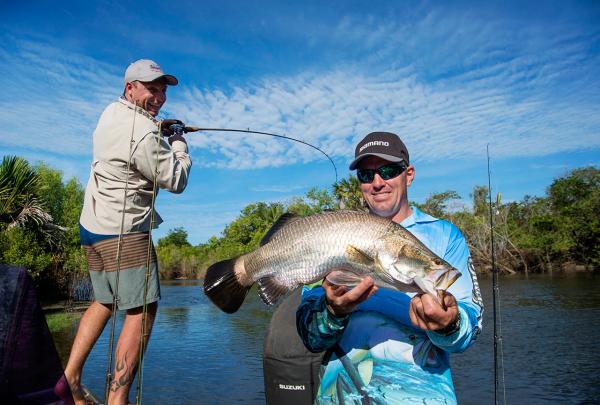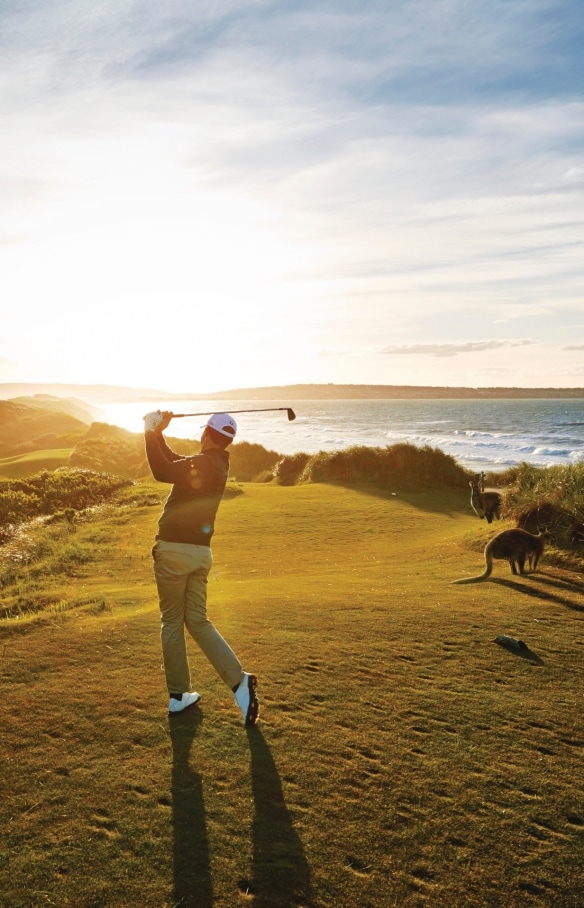
Top fishing experiences in Australia
From fly-fishing for trout in alpine streams to duelling with blue-water giants in the tropics, Australia offers some of the best fishing in the world.
By Simon Webster
Bag a barra in the Top End

Dhipirri Barra & Sportfishing, Arnhem Land, Northern Territory © Dhipirri Barra & Sportfishing
At up to 1.4 metres (more than 55 inches) long and weighing more than 40 kilograms (90 pounds), the barramundi is one of the world’s most exciting sport fish. An Australian icon, this giant perch takes the bait explosively and jumps and runs violently in titanic battles with the angler.
Catching a big barra is top of the bucket list for many anglers, and the tidal estuaries and rivers of the Northern Territory are among the best places to do it.
The Top End (Darwin and the northernmost part of the Northern Territory) also offers some spectacular blue-water sport fishing — with longtail tuna, queen fish and Spanish mackerel among the most popular species. The choice of operators and fishing experiences in the Top End is almost as vast as the array of fish.
Set up camp in a fishing lodge in Arnhem Land, on the Cobourg Peninsula or on Groote Eylandt. Arnhem Land is the perfect place to combine your fishing adventure with a cultural journey into Aboriginal Australia. You can even jump aboard a helicopter to go heli-fishing - whatever floats your (fishing) boat.
Best time of year: Varies. See NT fishing seasons.
Catch a chopper in the Kimberley

HeliSpirit, Ord River, Kununurra, the Kimberley, Western Australia © HeliSpirit
If you thought arriving at a new fishing spot by car or boat was exciting, heli-fishing will blow your mind. Western Australia’s rugged Kimberley region, with its outback waterfalls, gorges and dramatic coastline, is home to plenty of barramundi. But where are the best spots to catch them?
Just ask your helicopter pilot, who will whisk you off to fishing hotspots from billabongs to coastal flats in search of big, beautiful barra as well as mangrove jack, archer fish, grunter, catfish and more.
Heli-fishing adventures last from five hours to three days. You’ll get breathtaking views of the Kimberley and land in fishing spots most people can only dream about. Plus, you’ll be served food and drink over which you can share your fishing stories.
You can also fish for Kimberley barramundi on a one-day or multi-day Ord River adventure, or at a remote yet luxurious coastal camp where all-inclusive packages include gourmet meals, Aboriginal rock art tours, accommodation in beachfront bungalows and blue-water and estuary fishing.
Best time of year: Heli-fishing is available all year; January to May usually produces the most fish. Ord River Ultimate Adventures operates April to October. Kimberley Coastal Camp is open all year round.
Fish the Great Barrier Reef

Nomad Sportfishing Adventures, Great Barrier Reef, Queensland © Nomad Sportfishing Adventures
It’s one of the natural wonders of the world, the only living organism visible from space and home to more than 1,600 species of fish. Who could resist a fishing trip to the Great Barrier Reef?
A staggering 300,000 square kilometres (116,000 square miles) of pristine waters, idyllic islands and unbelievably beautiful coral cays make up the reef, and charter boats will take you to places where it feels like no-one has ever fished before.
Black and blue marlin, sailfish, dogtooth tuna, giant trevally and wahoo are among the incredible creatures that call the Great Barrier Reef home.
Operators up and down the reef include Far North Sports Fishing, East Coast Angling, Quest Angling Expeditions and the luxury live-aboard Elizabeth EII. Any of these operators can take you to some of the best fishing in the world.
While you’re here, jump into a wetsuit and combine your fishing trip with some diving for an unforgettable look at what’s going on beneath the surface.
Best time of year: Varies. See this species calendar.
Fly into Tasmania

Fishing at Thousand Lakes Lodge, Liawenee, Tasmania © Brad Harris
When you think of Australia, fly-fishing for trout in highland lakes may not be the first image that springs to mind. But Tasmania offers a superb array of fly-fishing options — everywhere from lakes to rapids to serene rivers — and arguably the purest strain of wild brown trout in the world.
Trout were introduced to Australia in the 1860s and thrive in the cooler parts of the country. Today, Tasmania is so renowned for fly-fishing excellence that it was selected to host the 2019 World Fly Fishing Championships. But you don’t have to be a champion to enjoy this sport.
Beginners and experts alike are welcome on one-day or multi-day wilderness fly-fishing adventures in search of brown or rainbow trout with RiverFly1864. Wade fish or soak up the serenity in a drift boat with Driftwater. Or take your pick from 1000 lakes during a stay at Thousand Lakes Lodge.
Your Tasmanian fishing adventures needn’t stop there. Tasmania also has sensational game fishing just 20 minutes offshore, with world-record-beating southern bluefin tuna among the prize catches.
Best time of year: August to April.
Nip offshore at Ningaloo

Ningaloo Fly Fishing, Exmouth, Western Australia © True Blue Bonefish
A rival to the Great Barrier Reef can be found right at the top of Western Australia. Ningaloo Reef may be smaller and less well-known than the illustrious reef on the east coast, but it is equally beautiful. World Heritage-listed, it is home to an incredibly diverse array of life and has one great advantage: it is so close to the shore in places that you can wade to it from the beach.
Stay inside the reef for sport or saltwater fly fishing or head beyond the reef (the continental shelf is pretty close to shore here) to tackle the big boys. From the coastal town of Exmouth you can join a Fly Fishing Frontiers or Ningaloo Fly Fishing charter to cast flies for bonefish in lagoons or seek sailfish out in the blue water.
Or head out from Coral Bay with Mahi Mahi Fishing Charters to take on marlin, sailfish and dolphin fish (mahi-mahi). Locals will tell you that the west is the best — and they’ve got a point.
Best time of year: The best season depends on the species you want to catch, but Exmouth is truly a year-round fishery. Additional information on species variety can be viewed here.
Toss a line in Mornington

Bay Fish N Trips, Mornington, Victoria © Bay Fish N Trips
Built during the Second World War, the stately vessel “Plover” represents the perfect platform for a wonderful half or full-day of fishing out on the expansive Port Phillip Bay, located on the Mornington Peninsula just over an hour south of Melbourne. With the Plover providing the space and comfort necessary for a day out on the water, Bay Fish N Trips aims to give anglers a full marine experience. Stuart, your skipper, has spent years exploring the waters of Port Phillip Bay and leads you to the most promising spots.
Pink snapper, King George whiting, flathead and gummy sharks are all prime targets, but half a dozen other species are always on the cards as well. Along with a tasty and nutritious lunch, all tackle and equipment is supplied, but clients are also free to bring their own.
Catch some city slickers in Sydney

Sydney Flyfishing, Sydney, New South Wales © Justin Duggan
It may be more famous for its Opera House and Harbour Bridge, but Sydney also happens to be a pretty special fishing destination.
“There’s a David Attenborough documentary taking place in the shadows of city buildings,” says Justin Duggan, who runs Sydney Flyfishing. “Just today, I saw big schools of Australian salmon under the Opera House destroying baitfish — with penguins in the middle of it all. It’s amazing.”
Duggan runs cruises through the waters of Pittwater, Broken Bay and the Hawkesbury River, as well as Sydney Harbour itself, in search of kingfish, Australian salmon, small tuna such as bonito, mackerel tuna and mulloway (jewfish).
What he finds differs, depending on the time of year. In winter, the waters might be bursting with salmon, but the warmer months can bring surprises such as longtail tuna. And from Botany Bay to Sydney Harbour, you’re fishing in destinations not only brimming with life, but history and beauty, too. Just don’t spend too long fishing in Sydney — there’s a whole continent to explore.
Best time of year: All year round.
Like the sound of sporting adventures? Check out these incredible golf courses.

























































































































